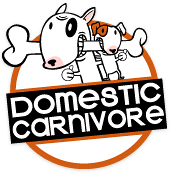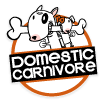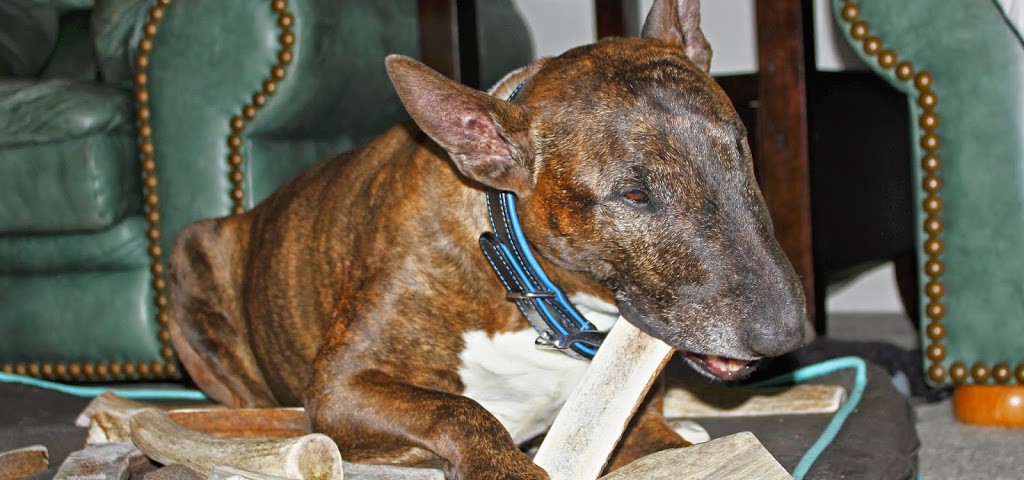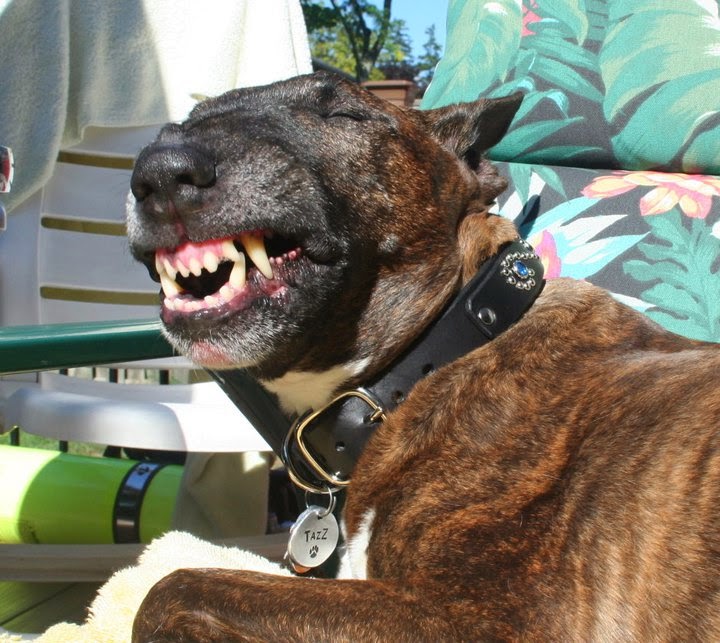The American Veterinary Medical Association states that over 80% of dogs and 70% of cats over 3 years of age have some form of periodontal disease. Periodontal disease has become the number one health issue for our pets. As a result, marketing teams are using this information and pet owners are being bombarded with dental chews, tablets, sprays, etc.
Responsible pet owners are continually looking for a way to keep their pet’s teeth and gums healthy, but they are also concerned with their pet’s cleanliness and odour. Owners will try anything to tackle stinky dog breath.
Why wait for a problem to exist? Prevent dental disease in your pet today. Preventative pet care is less expensive and much more pleasant for both the dog and the owner. In order to prevent a disease, we need to understand what causes it. Two of the main causes of periodontal disease are genetics and diet. While genetics can be chosen to a degree, we are generally dealing with pets that are already in a home.
Tazz showing off his pearly whites
For pets with plaque build up, the food is sticking to their teeth. The following are options that owners have to prevent and treat periodontal disease in their pets.
Traditional Tooth Brushing
Daily teeth brushing may help to reduce the amount of plaque build up, but occasional brushing is completely ineffective. In order to yield positive results, the pet owner must brush all of the pet’s teeth to the gum line. Remember that human toothpaste can be toxic to pets and many types of toothpaste for pets are full of synthetic ingredients and chemicals. If your pet suffers from food sensitivities and/or allergies, these products might not be the best option for them.
It also takes some training to familiarize your pet with teeth brushing. A standard toothbrush can be abrasive on the pet’s gums, causing pain and discomfort. Rubber finger brushes are a softer option. Pet toothpaste is said to contain enzymes that break down the plaque, but their effectiveness is questionable. Some owners have great success with daily tooth brushing, while others see little to no benefit.
Dental Scaling at Home
This is an option that we are not permitted to recommend. The Ontario Veterinary Act specifies that any dental care, beyond the use of a toothbrush, is considered veterinary medicine. Unfortunately, that means that scaling your pet’s teeth or hiring an anesthesia free dental hygienist is illegal in Ontario.
Professional Dental Scaling
Having your pet’s teeth scaled by a veterinarian is an extremely effective way to maintain excellent oral hygiene. This method of treatment is not without risk as it involves putting your pet under anesthetic. While the risk of complications is relatively low, I only put my dog under anesthetic for mandatory treatments. Putting an otherwise healthy dog under anesthetic for routine dental cleanings is not a risk I am willing to take. Professional dental cleaning is required if your pet is having difficulty eating because of periodontal disease or if your pet requires tooth extractions.
Rawhide and Dental Chews
These products are relatively new to the industry and their marketing has worked on millions of trusting pet owners. Domestic Carnivore would never carry these products, nor would we recommend them. I personally believe they are dangerous and ineffective. Rawhide is a by-product of the leather industry. Yes, that means your leather boots, couch, and jackets are made from a higher quality hide than what marketers are trying to feed your dog.
Chemical agents can be used during the production of rawhide. Additionally, most rawhide products are sourced outside of North America and take weeks to fully process. This leaves time for the hide to rot and many companies then bleach the finished product to make it more appealing to pet owners.
Dental chews are also formulated with a focus on human appeal. They come in a cute shape, but are ineffective in cleaning your dog’s teeth. The texture is wax-like and the idea behind them is that the pet sinks their teeth into the chew and scrapes away the plaque. In the past, I gave these chews to my dogs and they simply crunched them. The chew lasted less than a minute and there was never an opportunity for the chew to reach the top of their teeth where the plaque builds.
These chews are typically full of synthetic extracts. Synthetic vitamins and minerals aren’t recognized by the dog’s digestive system as real food, which makes it more difficult to digest. The added stress on your pet’s digestive system and organs as they try to break down these ingredients can be detrimental to their health.
Dental Sprays and Water Additives
I have had success with one dental spray, but I am very particular with the ingredients. The product I used was called Leba III and I used it for an older dog that was new to a raw diet and wasn’t using his entire mouth to chew bones. I used it twice/day for a month and I had great results. Leba III uses two types of herbs (mints and roses) that work to stimulate the enzymes present in your dog’s saliva.
Although I have not tried other sprays or water additives, I have yet to find one with ingredients that I would be comfortable with. I’m not confident that the synthetic ingredients and chemicals are safe for my pets. In fact, many of these products have warnings such as “keep out of reach of children” and “not intended for human use”. I question what would make these products “safe” for pets, but harmful for humans.
Natural Chews (Dehydrated Treats + Antlers)
Natural chews are a good option for many dogs, but their effectiveness as a dental chew will depend on the dog. Antler chews are a dense option and while a basic antler can be a long lasting chew, it can lead to broken teeth for an aggressive chewer. Split antlers are a much safer option as the dog can scrape out the marrow without trying to break the antler.
Tazz enjoys his splits elk antlers
Dehydrated chews are safe for all dogs and will help to reduce plaque in small dogs or delicate chewers. Duck feet, chicken feet, and oxtail tips are the most popular dehydrated chews, but due to their size, they are a quick snack for medium and large sized dogs.
Treats like pizzles and pig snouts are healthy options, but they will not scrape your pet’s teeth. They still offer great variety in their diet and your pet will love them.
Natural Tooth Brushing
Those of us who feed a balanced raw diet have likely noticed the dental benefits. A pre-made or ground raw diet doesn’t stick to the teeth the way processed kibble does and raw meaty bones help to eliminate the little bit of plaque that does build. How does Mother Nature take care of your dog’s oral health? First, the dog tears the meat off of the bone using their canine teeth and incisors. As they bite down and gnaw, their teeth scrape against the bone and remove any plaque build up. Dogs then use their molars and pre-molars to crunch the bones, providing a cleaning for their entire dentition.
Choosing the Right Bones
Large Dogs
Larger dogs require larger bones. I would consider any dog over 50lbs to be a large dog. Beef neck bones, turkey necks, duck frames, and whole rabbit are excellent, fully consumable options for large dogs. Due to their density, recreational bones, like beef marrow bones should only be given to light chewers. Aggressive chewers can break their teeth on weight bearing bones of large herbivores.
Medium Dogs
Medium sized dogs can enjoy any of the bones mentioned above as well as duck necks, lamb shanks, and goat necks.
Cats/Small Dogs
Small dogs and cats are the perfect size to enjoy just about any raw meaty bone you can find. Chicken backs, chicken necks, duck feet, chicken feet, elk ribs, and duck wings are all great options for a small carnivore. However, a larger meal like a beef neck bone or whole rabbit will give them a better dental workout.
It’s important for dogs and cats to have variety in their diet, so don’t limit them to only one type of raw meaty bone. Depending on the dog’s eating habits, a larger dog may be able to safely eat smaller bones. Many large and giant breed dogs do well with chicken backs and necks. The determining factor will be if they chew the food or if they try to inhale it.
Important Notes for Feeding Bones:
- Dogs can choke on anything (including kibble), so please monitor your pet while they enjoy bones and chews.
- Bones should never be cooked as this makes them brittle and indigestible.
- It is best to freeze any raw meat for a minimum of 3 days. Meat can contain parasites that are killed by freezing the meat for 48-72 hours. Bones are best served thawed, but they should go through a period of freezing prior to defrosting.
Conclusion
Properly caring for your pet’s teeth and gums will help to reduce the risk of diseases associated with poor oral hygiene. Along with periodontal disease, there are also studies showing a correlation between gum disease and heart disease.
As loving pet owners, we want our pets to have the best quality of life and that means keeping them happy and healthy. Visit your vet if you notice anything abnormal such as a growth, discoloured gums, loose or chipped teeth, or if your pet appears to have dental pain.
In our experience as pet owners, the most effective choice in preventing dental disease is a raw diet. Raw meaty bones are a safe and effective way to maintain healthy teeth and gums.
Domestic Carnivore will take the time to understand your pet’s needs so we can recommend an appropriate option for them. Keeping your pets happy and healthy is our passion.
Never compromise the health of your pet by falling for cleaver marketing plans. Research everything and expose yourself to differing opinions. Once you are armed with as much knowledge as possible, develop your own opinion, and be your pet’s advocate.
Remember to smile and enjoy the time you have with your pet





